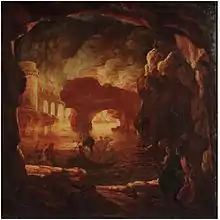Crescenzio Onofri
Crescenzio Onofri or Crescenzio d'Onofri (Rome, 23 May 1634 – Florence, 1712/1714) was an Italian landscape painter, draughtsman and engraver who worked in Rome and Florence. A presumed pupil of Gaspard Dughet he collaborated with many specialist figure painters of his time.[1]

Life
Information about Onofri's early life is scarce. Crescenzio Onofri was born in Rome but the date of his birth is not entirely clear and dates vary from 1630 to 1650.

Onofri is believed to have been one of the few pupils of Gaspard Dughet. Dughet was a painter of French descent who spent his whole life in Italy, where he became a pupil of Nicolas Poussin and a prominent landscape painter of the Roman Campagna.
Onofri worked in Rome for at least 20 years. He was involved in many decorative projects in the residences of prominent Roman families such as Pamphili, Rospigliosi, Pallavicini and Colonna families. In 1675 he was listed as a member of the Accademia di San Luca, one of the most prestigious organisations of artists in Rome.[2]
Onofri moved to Florence but art historians are not unanimous about the date of this move. Some place his transfer to Florence as early as 1689 and others in 1696.[1][3]
He worked until his death in circa 1712 in the service of the Grand Duke. In this period he is known to have collaborated with various artists who painted the figures in his landscapes, including Livio Mehus, Francesco Petrucci and Alessandro Magnasco.[1]
Work
Onofri was exclusively a landscape painter. He was one of the landscape artists whose style comes the closest to Dughet's Roman work. Typical of Onofrio's work are his carefully balanced compositions, which go back on the model of the classical landscape established in the early 17th century by Annibale Carracci and his pupils and in which the narrative element is reduced.[2]

The so-called 'ideal' landscape of the first half of the 17th century had in fact created compositional formulas that served as a model for numerous Italian and foreign artists. This style of classical landscape had an extraordinary development in the 17th and 18th centuries as is illustrated by the works of Dughet and Jan Frans van Bloemen. The success and spread of this genre of painting was linked to the preferences of the market and the taste of private clients. Important masters practicing the genre included Pietro da Cortona, Nicolas Poussin, Claude Lorrain and Gaspard Dughet, the master of Onofri.[4]
The numerous drawings by his hand demonstrate that Onofri was familiar with the works of the Bolognese artist Giovanni Francesco Grimaldi particularly in his meticulous technique of representing the foliage of trees. In his later years the artist evolved towards a looser and more painterly style.[5]
References
- Crescenzio Onofri (Rome 1632(?)-after 1712 Florence), An extensive landscape with a villa, figures in trees in the foreground at Bonhams.
- Classical Landscape at the National Inventory of Continental European Paintings
- Crescenzio Onofrij at the Netherlands Institute for Art History (in Dutch)
- Crescenzio Onofri, Paesaggio con pastori e armenti at the Banca d’Italia (in Italian)
- Onofri, Crescenzio at the Prado Museum site (in Spanish)
External links
![]() Media related to Crescenzio Onofri at Wikimedia Commons
Media related to Crescenzio Onofri at Wikimedia Commons
